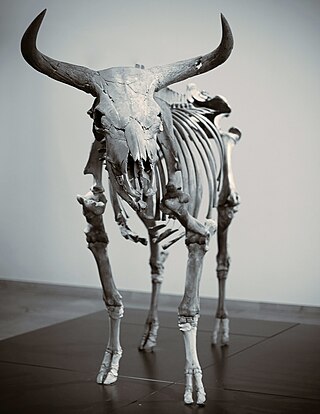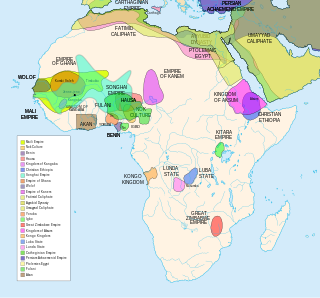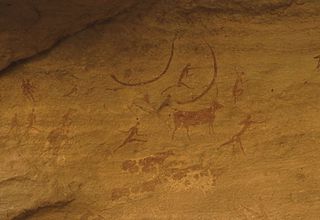
The aurochs is an extinct cattle species, considered to be the wild ancestor of modern domestic cattle. With a shoulder height of up to 180 cm (71 in) in bulls and 155 cm (61 in) in cows, it was one of the largest herbivores in the Holocene; it had massive elongated and broad horns that reached 80 cm (31 in) in length.

The history of Africa begins with the emergence of hominids, archaic humans and — around 300,000–250,000 years ago — anatomically modern humans, in East Africa, and continues unbroken into the present as a patchwork of diverse and politically developing nation states. The earliest known recorded history arose in Ancient Egypt, and later in Nubia, the Sahel, the Maghreb, and the Horn of Africa.

The history of Sudan refers to the territory that today makes up Republic of the Sudan and the state of South Sudan, which became independent in 2011. The territory of Sudan is geographically part of a larger African region, also known by the term "Sudan". The term is derived from Arabic: بلاد السودان bilād as-sūdān, or "land of the black people", and has sometimes been used more widely referring to the Sahel belt of West and Central Africa.

The zebu, sometimes known in the plural as indicine cattle or humped cattle, is a species or subspecies of domestic cattle originating in South Asia. Zebu are characterised by a fatty hump on their shoulders, a large dewlap, and sometimes drooping ears. Various breeds in the Sanga cattle subspecies exhibit humps as well. They are well adapted to withstanding high temperatures, and are farmed throughout the tropical countries, both as pure zebu and as hybrids with taurine cattle, the most prevalent domestic cattle subspecies.

Bovines comprise a diverse group of 10 genera of medium to large-sized ungulates, including cattle, bison, African buffalo, water buffalos, and the four-horned and spiral-horned antelopes. The evolutionary relationship between the members of the group is still debated, and their classification into loose tribes rather than formal subgroups reflects this uncertainty. General characteristics include cloven hooves and usually at least one of the sexes of a species having true horns. The largest extant bovine is the gaur.

Bos is the genus of wild and domestic cattle. Bos is often divided into four subgenera: Bos, Bibos, Novibos, and Poephagus, but including these last three divisions within the genus Bos without including Bison in the genus is believed to be polyphyletic by many workers on the classification of the genus since the 1980s. The genus as traditionally defined has five extant species but this rises to eight when the domesticated varieties are counted as separate species, and 10 when the closely related genus Bison is also included. Most but not all modern breeds of domesticated cattle are believed to have originated from the extinct aurochs. Many ancient breeds are thought to have originated from other species. Zebus and taurine cattle are thought to descend from ancient Indian and Middle Eastern aurochs, respectively.

The prehistory of North Africa spans the period of earliest human presence in the region to gradual onset of historicity in the Maghreb (Berber:Tamazgha) during classical antiquity. Early anatomically modern humans are known to have been present at Jebel Irhoud, in what is now Morocco, approximately 300,000 years ago. The Nile Valley region, via ancient Egypt, contributed to the Neolithic, Bronze Age and Iron Age periods of the Old World, along with the ancient Near East.

Makuria was a medieval Nubian kingdom in what is today northern Sudan and southern Egypt. Its capital was Dongola in the fertile Dongola Reach, and the kingdom is sometimes known by the name of its capital.
Uan Muhuggiag is an archaeological site in Libya that was occupied by pastoralists between the early Holocene and mid-Holocene; the Tashwinat mummy, which was found at Uan Muhuggiag, was dated to 5600 BP and presently resides in the Assaraya Alhamra Museum in Tripoli.
The prehistory of Africa spans from the earliest human presence in Africa until the ancient period in the history of Africa.

Sanga cattle is the collective name for indigenous cattle of sub-Saharan Africa. They are sometimes identified as a subspecies with the scientific name Bos taurus africanus. Their history of domestication and their origins in relation to taurine cattle, zebu cattle, and native African varieties of the ancestral aurochs are a matter of debate.

Nubia is a region along the Nile river encompassing the area between the first cataract of the Nile and the confluence of the Blue and White Niles, or more strictly, Al Dabbah. It was the seat of one of the earliest civilizations of ancient Africa, the Kerma culture, which lasted from around 2500 BC until its conquest by the New Kingdom of Egypt under Pharaoh Thutmose I around 1500 BC, whose heirs ruled most of Nubia for the next 400 years. Nubia was home to several empires, most prominently the Kingdom of Kush, which conquered Egypt in the eighth century BC during the reign of Piye and ruled the country as its 25th Dynasty.

The Indian aurochs is an extinct subspecies of aurochs that inhabited West Asia and the Indian subcontinent from the Late Pleistocene to its extinction during the South Asian Stone Age. With no remains younger than 3,800 YBP ever found, the Indian aurochs was the first of the three aurochs subspecies to become extinct, while the North African and Eurasian subspecies survived until the Roman and Modern times, respectively.

Banganarti is a small village in Sudan, about half way between the third and fourth cataract of the Nile. It is situated 10 kilometres (6.2 mi) from Old Dongola, the capital of Makuria. Banganarti was an important Christian pilgrim center; the remains of a substantial medieval church are near the village (18.166736,30.784785).
African village dogs are dogs found in Africa that are directly descended from an ancestral pool of indigenous dogs. African village dogs became the close companion of people in Africa, beginning in North Africa and spreading south.
Bir Kiseiba is a Neolithic archaeological site in Egypt, dating from approximately 11,000-5,000 BP, that lies approximately 250 km west of the Nile in Lower Nubia. Excavated by Fred Wendorf, Romauld Schild, and Angela Close, Bir Kiseiba, along with Nabta Playa, has some of the earliest evidence for food production, permanent settlement, and more diverse technologies as compared to sites from the Late Pleistocene. Wendorf and associates argue that cattle and pottery were here as early as any other place in Africa, although this assertion has been challenged.

The Throne Hall of Dongola, also known as the Mosque Building, is an archaeological site in Old Dongola, Sudan. It is a two-storey brick building situated on a rocky hill, overlooking the town and the Nile valley. It was originally built in the 9th century, serving as the richly adorned representative building of the Makurian kings. In 1317, during the period of Makurian decline, it was converted into a mosque, serving this purpose until it was closed and turned into a historic monument in 1969. Shortly afterwards Polish archaeologists from the Polish Centre of Mediterranean Archaeology of the University of Warsaw began to excavate the building. It has been described as possibly "the most important, symbolic edifice in the medieval history of Sudan". It is presently the oldest preserved mosque in Sudan.

The Dongola Reach is a reach of approximately 160 km in length stretching from the Fourth downriver to the Third Cataracts of the Nile in Upper Nubia, Sudan. Named after the Sudanese town of Dongola which dominates this part of the river, the reach was the heart of ancient Nubia.
R12 is a middle Neolithic cemetery located in the Northern Dongola Reach on the banks of the Seleim Nile palaeochannel of modern-day Sudan. The site is dated to between 5000 and 4000 BC. Centro Veneto di Studi Classici e Orientali excavated the site, within the concession of the Sudan Archaeological Research Society and after an agreement with it, between 2000 and 2003 over three digging seasons. The first was in 2000 and 33 graves were discovered. The second was in 2001 and another 33 graves were discovered. The third was in 2003 and the last 100 graves were discovered. There are 166 graves total at the site. Contents of the graves include ceramics, animal bones, grinding stones, human skeletons, and plant remains.

Pastoral rock art is the most common form of Central Saharan rock art, created in painted and engraved styles depicting pastoralists and bow-wielding hunters in scenes of animal husbandry, along with various animals, spanning from 6300 BCE to 700 BCE. The Pastoral Period is preceded by the Round Head Period and followed by the Caballine Period. The Early Pastoral Period spanned from 6300 BCE to 5400 BCE. Domesticated cattle were brought to the Central Sahara, and given the opportunity for becoming socially distinguished, to develop food surplus, as well as to acquire and aggregate wealth, led to the adoption of a cattle pastoral economy by some Central Saharan hunter-gatherers of the Late Acacus. In exchange, cultural information regarding utilization of vegetation in the Central Sahara was shared by Late Acacus hunter-gatherers with incoming Early Pastoral peoples.















